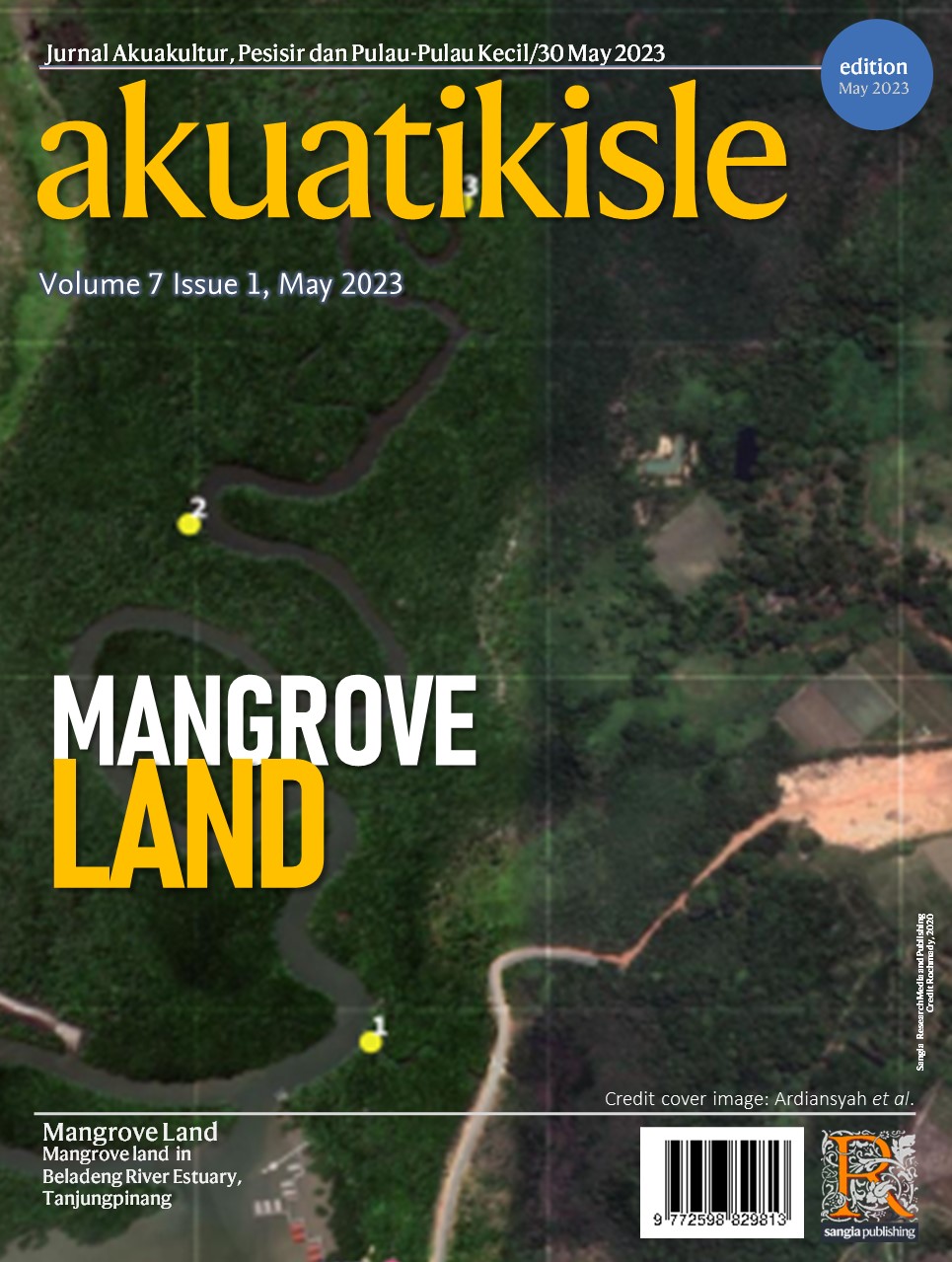Akuatikisle: Jurnal Akuakultur, Pesisir dan Pulau-Pulau Kecil
Full Length Article
Comparison of probiotics with different concentrations on the growth and survival rate of Bonylip Barb (Osteochilus vittatus)
Highlights
Generate NLP AI by Wizdam ID.
Abstract
Bonylip barb (Osteochilus vittatus) is one of Indonesia's local fish which is starting to bloom in cultivation. One of the important needs in the development of fish farming is feed, to increase feed efficiency by providing probiotics which play a role in increasing growth, survival rates, digestibility, feed efficiency, the immune system and the composition of beneficial bacteria in the digestive tract of fish. This study aims to compare the concentration of different probiotics in commercial feed on the growth and survival of barley nilem (Osteochilus vittatus). The research was conducted at Pandaan Aquaculture Installation (IPB), Pasuruan Regency, East Java. Experimental study using a completely randomized design (CRD) with four treatments and three replications. Statistical analysis to compare growth performance (length and weight) and survival of nilem fish used analysis of variance (ANOVA) test. The results showed that there were differences in the growth of weight, length, and survival of barley nilem (Osteochilus vittatus) on commercial feed with different concentrations of probiotics. Where there is a tendency that the higher the concentration of probiotics in commercial feed, the higher the growth in length and weight and survival of nilem fish (O. vittatus).
Keywords
Introduction
Section snippets
Material and Methods
Materials and methods from the full-text PDF of this article cannot be displayed.
Results
Results from the full-text PDF of this article cannot be displayed.
Discussion
Discussion from the full-text PDF of this article cannot be displayed.
Conclusions
Conclusions from the full-text PDF of this article cannot be displayed.
Acknowledgment
Acknowledgment from the full-text PDF of this article cannot be displayed.
Competing interest
The authors declare that they have no known competing financial interests or personal relationships that could have appeared to influence the work reported in this paper.
Conflict of interest
The authors declare that the research was conducted in the absence of any commercial or financial relationships that could be construed as a potential conflict of interest.
Ethical approval acknowledgements
No ethical approval required for this article. All procedures followed were in accordance with the ethical standards of the responsible committee on human experimentation (institutional and national) and with the Helsinki Declaration of 1975, as revised in 2008 (5)
Supplementary files
Data sharing not applicable to this article as no datasets were generated or analysed during the current study, and/or contains supplementary material, which is available to authorized users.
References (25)
Agustina, D. .; Marnani, S. & Irianto, A., 2006. Pengaruh Pola Pemberian Probiotik A3-51 Peroral terhadap Kelangsungan Hidup Bawal Air Tawar (Collosoma macropomum Bry) setelah Di Uji Tantang dengan Bakteri. Universitas Jendral Sudirman.
Arief, M.; Nur, F. & Sri, S., 2015. Pengaruh Pemberian Probiotik Berbeda Pada Pakan Komersial terhadap Pertumbuhan dan Efisiensi Pakan Ikan Lele Sangkuriang (Clarias Sp.). Jurnal Ilmiah Perikanan dan Kelautan, 6(1): 1–5.
Arsyad, R., Muharam, A., Syamsudin. 2015. Kajian Aplikasi Probiotik Dari Bahan Baku Lokal Terhadap Pertumbuhan Dan Tingkat Kelangsungan Hidup Benih Ikan Nila (Oreochronis niloticus). Jurnal Ilmiah Perikanan Dan Kelautan Universitas Negri Gorontalo. Vol 3. No 2:5 1-57.
Boeuf, G. & Payan, P., 2001. How Should Salinity Influence Fish Growth? Comparative Biochemistry and Physiology-Part C. Toxicology & Pharmacology, 130(1): 411–423, DOI: https://doi.org/10.1016/S1532-0456(01)00268-X.
Dahril, I.; Tang, U. . & Putra, I., 2017. Pengaruh Salinitas Berbeda Terhadap Pertumbuhan dan Kelulusanhidupan Benih Ikan Nla Metah (Orechromis sp.). Jurnal Berkala Perikan Terubuk, 45(3): 1–10.
Effendi, H., 2003. Telaah Kualitas Air Bagi Pengelolaan Sumber Daya dan Lingkungan Perairan. Yogyakarta: Kanisiun.
Effendi, M. ., 2012. Biologi Perikanan. Yogyakarta: Yayasan Pustaka Nusatama.
Hendrianto & Zaeni, A., 2009. Aplikasi Imuno-Probiotik dalam Pendederan Kerapu Macan (Ephinepelus fuscoguttatus) dan Dampaknya Terhadap Imunitas dan Tingkat Kelulushidupan. Universitas Batam.
Irabarren, D.; Daga, P.; Moreira, M. . & Feijoo, G., 2012. Potensi environmental effects of probiotics used in aquaculture. Aquaculture Nutrition, 16(2): 407–411.
Khairuman, 2014. Buku Pintar Budidaya 15 Ikan Konsumsi. Jakarta: Penerbit Agromedia Pustaka.
Latuconsina, H. 2020. Ekologi Ikan Perairan Tropis: Biodiversitas, Adaptasi, Ancaman, dan Pengelolaan. Yogyakarta: Gadjah Mada University Press.
Mulyadi, A. ., 2011. Pengaruh Pemberian Probiotik Pada Pakan Komersil Terhadap Laju Pertumbuhan Benih Ikan Patin Siam (Pangasius hypopthalamus). Universitas Padjajaran Bandung.
Mulyani, Y. S.; Yulisman & Fitrani, M., 2014. Pertumbuhan Dan Efisiensi Pakan Ikan Nila (Oreochromis niloticus) Yang Dipuasakan Secara Periodik. Jurnal Akuakultur Rawa Indonesia, 2(1): 1–12.
Mulyasari, D. .; Soelistyowati, A. .; Kristanto & Kusmini, I. ., 2010. Karakteristik Genetik Enam Populasi Ikan Nilem (Osteochilus hasselti) di Jawa Barat. Jurnal Riset Akuakultur, 5(2): 175–182.
Nugroho, R. A.; Pambudi, L. T. & Haditomo, A. H. C., 2012. Aplikasi teknologi akuaponik pada budidaya ikan air tawar untuk optimalisasi kapasitas produksi. Jurnal saintek perikanan, 8 (1): 46–51.
Pramleonita, M.; Yuliani, N.; Arizal, R. & Wardoyo, S. ., 2018. Parameter fisika dan Kimia Air Kolam Ikan Nila Hitam (Oroechromis niloticus). Journal Sains Natural Universitas Nusa Bangsa, 8(1): 119–126.
Putra, A. N.; Widanami & Utomo, N. B. ., 2015. Growth Performance of Tilapia (Oreochromis niloticus) Fed with Probiotic, Prebiotic and Synbiotic in Diet. Pakistan Journal of Nutrition, 14(5): 263–268.
Rachmawati D., Samidjan I. & Setyono H., 2015. Manajemen Kualitas Air Media Budidaya Ikan Lele Sangkuriang (Clarias gariepinus) dengan Teknik Probiotik pada Kolam Terpal di Desa Vokasi Reksosari, Kecamatan Suruh, Kabupaten Semarang. Pena Akuatika: Jurnal Ilmiah Perikanan dan Kelautan, 12(1).
Saifuddin & Tantra, I. K. M., 2019. PEMELIHARAAN LARVA UDANG WINDU (Penaeus monodon) DENGAN PEMBERIAN PROBIOTIK YANG BERBEDA. Akuakultur, 3(2)(2005): 45–49.
Septiana M. A., Agus M. & Pranggono H., 2017. Pengaruh pemberian probiotik dengan dosis yang berbeda terhadap pertumbuhan benih ikan bandeng (Chanos chanos FORKSAL). Pena Akuatika: Jurnal Ilmiah Perikanan dan Kelautan, 15(1).
Setiawati, S., Latuconsina, H., Prasetyo, H.D. 2022. Daya Tetas Telur dan Sintasan Larva ikan Nilem (Osteochilus vittatus ; Valenciennes, 1842) pada Media Pemeliharaan dengan pH Air Berbeda
Sitompul, N., 2020. Pengaruh Penambahan Berbagai Sumber Beta Karoten Alami Pada Pakan dengan Padat Tebar yang Berbeda terhadap Pertumbuhan dan Kecerahan Warna Ikan Koi (Cyprinus carpio). Universitas Sumatra Utara.
Subandiyono & Hastuti, S., 2010. Buku Ajar Nutrisi Ikan. Semarang: Universitas Diponegoro.
Wicaksono, P., 2005. Pengaruh Padat Tebar Terhadap Pertumbuhan dan Kelangsungan Hidup Ikan Nilem Osteochilus hasselti C.V. yang dipelihara dalam Keramba Jaring Apung di Waduk Cirata dengan Pakan Perifiton. Institut Pertanian Bogor.
Widiyaningsih, E. N., 2011. Peran Probiotik Untuk Kesehatan. Jurnal Universitas Muhammadiyah Surakarta, 4(1): 14–20.
Bibliographic Information
Cite this article as:
-
Submitted
30 November 2022 -
Revised
31 December 2022 -
Accepted
15 January 2023 -
Published
29 January 2023 -
Version of record
30 March 2023 -
Issue date
30 May 2023
Copyright
Sangia Advertisement
Copyright © 2023 Fatimatus Saadah, Ratna Djuniwati Lisminingsih, Husain Latuconsina. Sangia Research Media and Publishing. Production and hosting by Sangia (SRM™).  This work is licensed under a Creative Commons Attribution-ShareAlike 4.0 International License.
This work is licensed under a Creative Commons Attribution-ShareAlike 4.0 International License.
Disclaimer: All claims expressed in this article are solely those of the authors and do not necessarily represent those of their affiliated organizations, or those of the publisher, the editors and the reviewers. Any product that may be evaluated in this article or claim that may be made by its manufacturer is not guaranteed or endorsed by the publisher.
Comments on this article
By submitting a comment you agree to abide by our Terms and Community Guidelines. If you find something abusive or that does not comply with our terms or guidelines please flag it as inappropriate.









